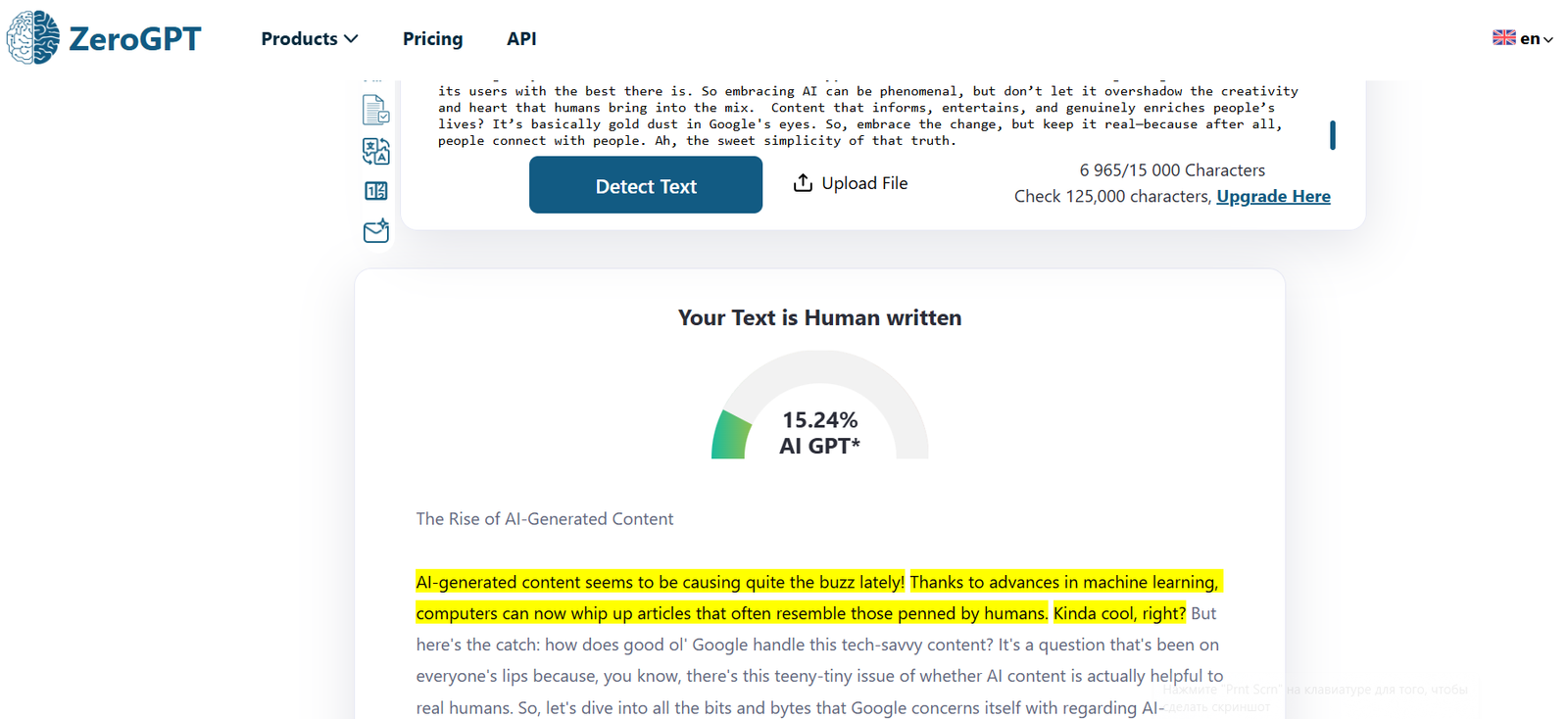The Rise of AI-Generated Content
AI-generated content seems to be causing quite the buzz lately! Thanks to advances in machine learning, computers can now whip up articles that often resemble those penned by humans. Kinda cool, right? But here’s the catch: how does good ol’ Google handle this tech-savvy content? 😅 It’s a question that’s been on everyone’s lips because, you know, there’s this teeny-tiny issue of whether AI content is actually helpful to real humans. So, let’s dive into all the bits and bytes that Google concerns itself with regarding AI-generated articles. See, as more writers lean on AI tools, the allure of producing engaging content at lightning speed becomes so real (and who doesn’t wanna save time?). But wait—Google’s not-so-simple algorithm has a huge role in determining whether your AI masterpiece will shine or get lost in the sea of URLs.
Google’s Stance on AI-Generated Content
Now, let’s get to the nitty-gritty details. Google’s had quite a journey figuring out how to deal with AI content. And, trust me, they’ve got a clear stance: it’s all about quality. No surprise there! Google wouldn’t be Google if it didn’t stick by its principle of delivering “useful and relevant results.” So, AI or not, if the content doesn’t add value, Google’s not too impressed. 👀 Man, was it dramatic when Google stated it might penalize poor AI content just like any other low-quality stuff! This means using AI tools can be a double-edged sword. If misused, it might hurt your SEO rather than help. Simply throwing words together without intent isn’t going to cut it anymore—Google expects content that answers questions, solves problems, or, well, genuinely educates or entertains.
What Makes Content “Quality” in Google’s Eyes?
Alright, let’s break it down: high-quality content has been, and probably always will be, the holy grail for rankings. What’s Google’s idea of quality, though? Picture this: you’re explaining a tricky topic to a friend. You want them to *get it*, right? That’s the vibe Google wants. You should aim for:
- Authority: Show off your sources and let readers know you’re trustworthy. Back those claims up!
- Relevance: Make sure your content fits the mold of what folks are genuinely searching for.
- Originality: Be unique! Nobody wants to read something they’ve seen a million times before.
- Readability: Ditch the jargon and complex phrases. Keep it simple, silly!
- Engagement: Encourage sharing, comments, and interaction.
Oh, and did I mention that Google loves when content is structured like a … hmm, like a well-organized library? Headings, subheadings, and bullet lists (obviously) help Google understand what’s going on.
The Algorithm: A Moving Target
The big G has built an algorithm, a beast of its own, really, and the goalposts keep moving. One day you’re acing it with your rankings, the next, poof, you’re wondering what hit your traffic! Google’s constant updates can be a little disorienting, with each change seeking ways to reward great content and weed out the less impressive stuff. Some updates really shook things up, making website owners everywhere groan in unison. 🙄 Why so many changes, you wonder? Google’s tweaking that algorithm specifically to improve accuracy in understanding what people intend when they search and also to intelligently assess the quality of content—AI or human-generated.
Human Touch: More Important Than You Think!
Technically speaking, AI is impeccable—yet that’s also its downfall. AI-generated content sometimes reads too perfectly. A funny irony, huh? We humans adore a sprinkle of imperfection. Those slight slips or human errors? Google spots them too and savor them like sprinkles on a cupcake. 🍰 Stories and experiences—those create a connection. So how can AI mimic one’s unique insights or little anecdotes? It can’t. Well, not convincingly, at least. It’s good practice to intertwine machine-generated drafts with some good ol’-fashioned human flair. A simple way to blend AI-generated content with your own personality is this: once a text draft is complete, go back, weave in personal stories, and sometimes, literally, go off-script. The slight disarray gives the writing a soul, something readers and Google can’t help but love!
Google’s Penalties: Not Just for AI, but Mind You…
That sudden dip in search rankings—yeah, no one’s a fan of that. But Google’s penalties don’t just target AI-specific faux pas. It’s about quality. Again! Overuse keyword stuffing, hidden texts, or misleading metadata, and you’re asking for it. Google wants to provide value, and if your content screams trickery over authenticity, prepare for some sort of time-out. 🚫 A piece of advice: don’t rely solely on AI to handle your keywords. Balance them (think of Carbs-to-Protein kind of balance) to maintain trust with both Google and your readers. Folks forget about their audience when they let a machine dictate the tone entirely.
AI Content and SEO: Strategies That Work
SEO and AI-generated content can mingle quite well if you strike the right balance! Start with keyword planning; think like Sherlock Holmes, not spammers. Go after those semantic keywords. Enhance the content with proper internal linking strategies that google-bot would happily crawl. And you might, just might, get away with a win! But wait—don’t forget multimedia! Give those words space to breathe with some visual aid. Maybe a smashing infographic or a sleek table will do wonders for comprehension and engagement (unless you’re spilling grandma’s secret cookie recipe… that’s all fluff, haha). Here’s a simple setup to consider:
| Content Type | SEO Benefit |
|---|---|
| Infographics | Boosts engagement and backlink potential |
| Videos | Increases time on page |
| Tables | Aids in quick data comprehension |
Adapting to Google’s Dynamic Nature
Honestly, adapting to Google’s whims can be a little like riding an emotional roller coaster. Hang tight though! Stay informed about updates. Follow Google’s blog like it’s your morning news; they don’t usually hold back on sharing insights into their mysterious changes. And who knows? Some of those updates might just work in your favor. 🎢 Remember these three golden rules:
- Stay current: With SEO trends and sample drafts.
- Value first: Everything else second.
- Be ready: Always for that next wave.
Conclusion: Embrace AI but Flourish Human
Whew! So, after a whirlwind tour through how Google treats AI-generated content, you might still have thoughts swirling in your head. It’s understandable… But hey, at least we’re sure about one thing: Google wants to serve its users with the best there is. So embracing AI can be phenomenal, but don’t let it overshadow the creativity and heart that humans bring into the mix. ❤️ Content that informs, entertains, and genuinely enriches people’s lives? It’s basically gold dust in Google’s eyes. So, embrace the change, but keep it real—because after all, people connect with people. Ah, the sweet simplicity of that truth.
📝 This article was created and published automatically by our WordPress plugin AUTO-POST-Yoast SEO ⚡.
🔍 SEO parameters were generated and applied automatically to boost visibility in search engines 🚀.
Write a long-form article in English about: “How Google Treats AI-Generated Content”.
Requirements:
Length: at least 2000–2500 words (≈5000–7000 characters).
Style: natural, human-like, with occasional imperfections:
Use a mix of short and long sentences.
Start some sentences with “And”, “But”, “Or”, or questions.
Include small human touches like “well”, “honestly”, or “you know what I mean?”.
Structure:
Use and
headings for logical sections.
Include at least one bulleted list and one numbered list.
Add a simple table if relevant (HTML table).
Add 1–2 emojis in each main section naturally to increase engagement.
Include small cultural or SEO anecdotes to make it feel written by a real person.
Ensure the text looks unique and passes AI detectors with less than 25% AI probability.
Goal: The final text must read like a human expert in SEO wrote it, with light humor and storytelling, covering how Google evaluates, ranks, and handles AI-generated content in search results.


